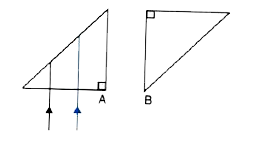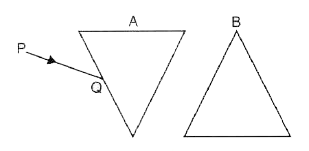(a) Figure shows two isosceles right angled prisms A and B and the light rays incident on the prism A. complete the diagram to show the rays emerging out of the prism B.
(b) State the principle used for completing the ray diagram in part (a) above.

(a) The completed ray diagram is given below in figure.

(b) The following two principles have been used :
(i) The ray of light falling normally on the glass-air surface or air-glass surface, passes undeviated through it (i.e., if i=0∘,r=0∘).
(ii) The ray of light ravelling from glass, when strikes the glass-air surface at an angle of incidence equal to 45∘ which is greater than the critical angle (=42∘ for glass-air), sufers total internal reflection.
Topper's Solved these Questions
- REFRACTION OF LIGHT AT PLANE SURFACESBOOK - ICSECHAPTER - REFRACTION OF LIGHT AT PLANE SURFACESEXERCISE - EXERCISE-4(A)
31 Videos
- REFRACTION OF LIGHT AT PLANE SURFACESBOOK - ICSECHAPTER - REFRACTION OF LIGHT AT PLANE SURFACESEXERCISE - EXERCISE-4(A) MULTIPLE CHOICE TYPE
3 Videos
- REFRACTION OF LIGHTBOOK - ICSECHAPTER - REFRACTION OF LIGHTEXERCISE - DIAGRAM BASED MCQ:
5 Videos
- REFRACTION THROUGH A LENS BOOK - ICSECHAPTER - REFRACTION THROUGH A LENS EXERCISE - EXERCISE-5(D) (MULTIPLE CHOICE TYPE)
2 Videos
Similar Questions
Figure shows two identical prisms P and Q placed with their faces parallel to each other. A light ray AB of yellow colour is incident at the face of the prism P. Complete the diagram to show the path of the ray till it emerges out of the prism Q.

View SolutionFigure alongside shows an equilateral prism ABC and the ray QR emerging out from the prism after suffering minimum deviation. Complete the diagram to show the refracted ray PQ inside the prism and the incident ray OP on the prism. State in words how have you completed the diagram to show the refracted ray PQ inside the prism and the incident ray OP on the prism. state in words how have you completed the diagram.

View SolutionFigure below shows two identical prisms A and B placed with their faces parallel to each other. A ray of light of single colour PQ is incident at the face of the prism A. complete the diagram to show the path of the ray till it emerges out of the prism B.

View SolutionFigure below shows a light ray of green colour incident on the prisms A,B and C. in each case, draw the path of the ray of light as it enters and emergest out of the prism. Mark the angle wherever necessary.

View SolutionThe diagram shows five isosceles right angled prisms.A light ray incident at90∘at the first face emerge at same angle with the normal from the last face.Which of the following relations will hold regarding the refractive indices?

View SolutionIn figure, a ray of light PQ is incident normally on the hypotenuse of an isosceles right angled prism ABC. (a) complete the path of the ray PQ till it emerges from the prism. Mark in the diagram the angle wherever necessary. (b) what is the angle of deviation of the ray PQ ?
(c) Name a device in which this action is used.

View SolutionComplete the path of the monochromatic light ray AB incident on the surface PQ of the equilateral glass prism PQR till it emerges out of the prism due to refraction.

View SolutionFigure shows graph of deviation δ versus angle of incidence for a light ray striking a prism. Angle of prism is

View SolutionComplete the path of the ray AB through the glass prism in PQR till it emerges out of the prism. Given the critical angle of the glass as 42∘.

View SolutionA ray of light PQ is incident normally on the hypotenuse of a right angled prism ABC as shown in the diagram given below:
Copy the diagram and complete the path of the ray PQ till it emerges from the prism.
View Solution
